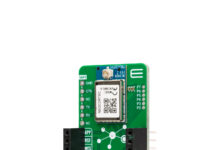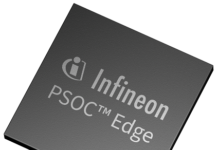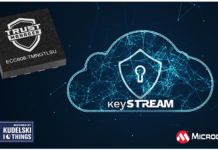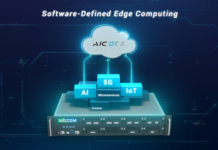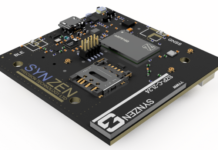
If one thing is growing as fast as the Internet of Things (IoT), it is the suite of wireless technologies that are essential to its connectivity and, ultimately, its success. Not only does one have to be aware of the options with existing technologies, but these constantly evolve and upgrade, and new approaches appear to add to the options. This technical article looks at both the established IoT-related protocols and the emerging ones too.
Bluetooth
Bluetooth has been around for a considerable time and has received numerous updates, culminating in the release of the latest version (Bluetooth 5) in December 2016. This was a significant upgrade over previous versions and included features intended to enhance IoT applications, especially Bluetooth Low Energy (BLE). The data rate doubled to 2Mbps, which required significantly greater transmission power (+20dB). However, as data is transmitted faster, overall power consumption is lower than with previous generations. The range has also increased to around four times what was possible with Bluetooth 4.2 BLE, with 244m a theoretical possibility. Even though the full range cannot be reached with the 2Mbps data rate, the performance remains highly impressive.
Bluetooth beacons are set to revolutionize marketing and advertising, and the continued iterations of Bluetooth are having a huge impact on the capabilities of these devices. Bluetooth 5 now allows for a data payload of 255 bytes in a single packet, eight times the previous limit of 31 bytes. As more data can be sent in a single message, receiver complexity is lowered as web connectivity and dedicated apps are no longer required.
The greater capabilities offered by Bluetooth 5 increase system efficiency and enable the support of more devices. It is now possible for a beacon to cover entire buildings in both consumer and commercial applications. Beacons are now able to deliver low-quality audio and video streaming as well as supporting short bursts of high-intensity data to deliver high-quality images.
Thread Mesh Networking
Mesh networking is a hot topic within IoT communications, and Thread was conceived specifically to deliver robust and reliable IoT infrastructure, eventually becoming the mainstay of smart homes the world over. However, Thread has failed to live up to its potential – at least so far. Several industry “names” have provided support since the inception of the Thread Group in 2014, but this support has not yet generated sales. Apple joined the group recently and many expected it to utilize Thread in its HomeKit solution, but there has been no announcement to confirm this – yet.
One key advantage of Thread is its resilience. Within the mesh, if node malfunctions then the other nodes can find another route to connect to each other. It is highly scalable, allowing up to 250 nodes to be connected. Despite these advantages, it is also very frugal with power, allowing nodes to be completely powered by AA batteries that will last for years. This is significant in applications such as security and monitoring, where power outages have no effect on Thread networks.
Thread networks are also highly secure and every transmission via the mesh is fully encrypted from end to end. Other technologies including ZigBee and Z-Wave incorporate AES encryption, but Thread takes security to the next level by relying on banking-class public-key cryptography.
Fragmentation and standards rivalry often slow the growth of new technologies. To address this in the home automation arena, the Thread Group and ZigBee Alliance got together to define the Dotdot 1.0 specification and the Dotdot-over-Thread certification program. As a result, the two networks became interoperable. Around the same time, Alphabet’s Nest business was folded back into Google, becoming part of its hardware division, which is known for the intelligent Google Home speakers and Pixel smartphones. The goal here was to build a more thoughtful home by incorporating the artificial intelligence from Google Assistant into Nest.
Although Thread set out to create an environment where devices could communicate without the need for an intermediary hub, Google Assistant has a lot to offer. Nest uses a combination of Thread, Wi-Fi and Bluetooth, making it one of the few products that directly support Thread. However, any device that is 802.15.4 compatible can download Thread software and operate on the protocol, so there are few barriers to adoption.
LoRaWAN
LoRa is named for its long-range capabilities and, in common with other non-cellular low-power wide-area network (LPWAN) protocols it utilizes the industrial, scientific and medical (ISM) frequency band. These frequencies are allocated globally to businesses in these areas and are away from those used by mobile networks, to avoid interference. As an additional benefit, they are free to use. Applications that benefit from LoRaWAN include asset tracking, supply chain, agriculture, smart cities, intelligent buildings, home automation and smart metering. LoRaWAN installations can be powered by batteries that will last for up to 20 years, removing the need for a fixed power source or the associated wiring.
The interoperability of the LoRaWAN protocol is assured by the LoRa Alliance, a collaborative not-for-profit group of over 500 members that defines and updates the protocol. Based on figures from the alliance, there were around 80 million deployments of LoRa-capable nodes during 2018, an increase of 60% over the prior year.
With a transmission range that can reach 10km, LoRaWAN is also capable of penetrating dense building materials, leading to a significant number of deployments within buildings where it is even possible to service basements and other below-ground locations such as underground car parks. Compared to Wi-Fi, integrated AES-128 encryption provides greater security and the ability to cover many more nodes, which means that fewer gateways are required. The encoding of packets means that messages sent via LoRaWAN are less likely to collide due to differing frequencies/data rates – thereby increasing the capacity of gateways. Public network operators with large customer counts often choose LoRaWAN due to the ability of a single gateway to support millions of messages.
However, some would argue that LoRaWAN is not a truly open system as, since Semtech acquired the technology from Cycleo in 2012, its chipsets are dominant providers of the LoRaWAN stack. Along with other LPWAN technologies such as Sigfox, LoRaWAN is potentially going to be outshone by cellular IoT technologies including LTE-M, NB-IoT and 5G that have been developed by major telecom companies – and are therefore backed by their marketing might.
| Protocol | Bluetooth 5 | Thread | LoRa | LTE-M | NB-IoT | 5G |
| Type | LPWAN | LPWAN | LPWAN | Cellular | Cellular | Cellular |
| Range | >200m
(but mainly for beacons) |
<35m
(but for mesh networking) |
5 to 10km | <10km | <10km | <10km (though will be much shorter for sub-GHz bands) |
| Power consumption | Ultra-low | Relatively low | Low | Low | Low | Significantly lower than LTE-M/NB-IoT |
| Latency | Relatively low | Relatively high | High | Low | Low | Ultra-low |
| Frequency band | 2.4GHz | 2.4GHz | 868MHz ISM | Multiple bands | Multiple bands | Multiple bands |
| Service cost | Free | Free | Free | Charged service | Charged service | Charged service |
| Data rate | 2Mbps | 0.25Mbps | 10kbps | 10Mbps | 250kbps | 1 to 10Gbps |
Table 1: There are multiple wireless technologies vying for space in the IoT arena.
LTE-M
LTE-M is the commonly used abbreviation for LTE (Cat M-1), the first protocol intended for low-power, low-cost IoT that uses the LTE platform. It uses the 1.4MHz spectrum instead of 20MHz, and supports average upload speeds in the range from 200kbps to 400kbps with a transmit power of 20dBm. The inbuilt power saving mode (PSM) allows nodes to be in “deep sleep” while waking up occasionally to maintain their network registration – a process known as extended discontinuous reception (eDRX).
LTE-M is being assessed for many applications in the industrial space, including smart pallets, smart shelving, container monitoring and fleet management of connected vehicles. The frequency of transmission can vary significantly in these applications from multiple times per day to a single transmission. Some intelligent devices remain in sleep mode until a predefined threshold is crossed and then wake to transmit their data.
Within the LTE-M system, nodes connect directly without requiring a gateway, thereby reducing cost. Also, it is not required to replace antennas, although the software is updated regularly to keep nodes current. As LTE-M only requires a half-duplex operation, the main ICs are lower cost than those used in full-duplex devices – reflecting the low bit rate and periodic nature of the data.
NB-IoT
Narrowband IoT, known as NB-IoT or Cat M-2, is similar to LTE-M although it relies on unused bandwidth to transmit data within the GSM and LTE networks. There are many potential applications such as smart metering, retail, vending machines, smart parking, tracking livestock, fire sensors and smart lighting, as well as the monitoring of slower-changing parameters including pollution, soil acidity and moisture levels. Compared to LTE, NB-IoT is unable to carry voice data, but it can operate with lower bandwidth and costs less to implement – so the best implementation depends on the application.
5G: The Future?
Although relatively recent innovations, LTE-M and NB-IoT are showing rapid development and progress. These types of LPWAN technologies are claimed by the GSMA to be ready for the “network of networks” that will be 5G communications, and they will coexist with the 5G technology.
The growth of all types of cellular and non-cellular LPWANs is spectacular and estimated by ABI Research to be around 53% CAGR at least until 2023 or so. This will be fueled by the spike in demand for asset trackers and smart meters, neither of which require 5G technology. After this time, non-cellular technologies will wane according to the report, accounting for just over half of all connections while cellular connectivity becomes dominant. However, due to the large-scale deployment, the non-cellular technologies are expected to continue alongside the cellular rollout for many years.
As technology is changing so fast, the future is somewhat hard to forecast, especially when related to the IoT. Many applications do not need 5G performance and these will most likely remain LPWAN based to avoid the costs associated with 5G. However, more sophisticated applications, including fully autonomous vehicles, will require the ultra-low latency and flexibility that 5G offers, especially for safety-related functionality.



